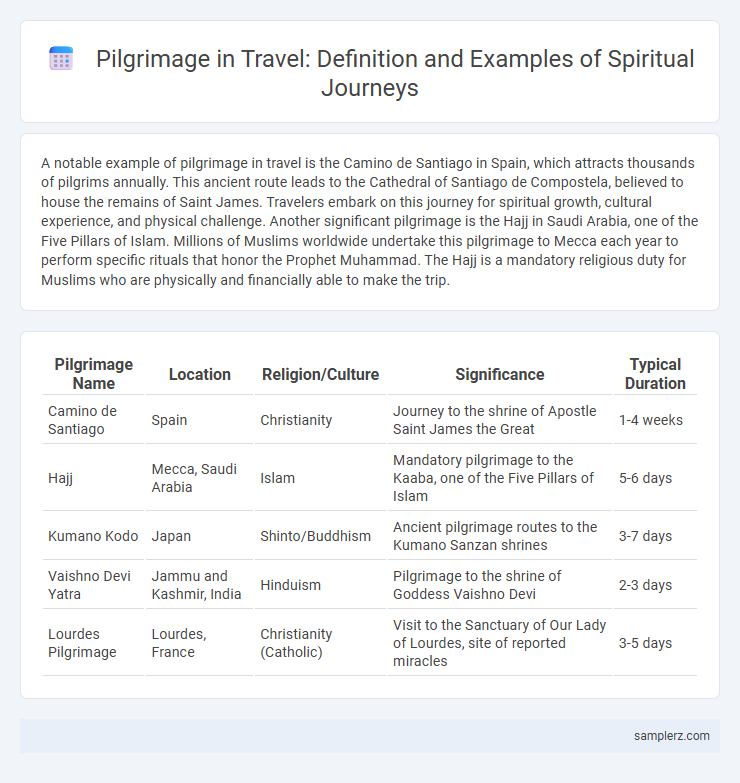A notable example of pilgrimage in travel is the Camino de Santiago in Spain, which attracts thousands of pilgrims annually. This ancient route leads to the Cathedral of Santiago de Compostela, believed to house the remains of Saint James. Travelers embark on this journey for spiritual growth, cultural experience, and physical challenge. Another significant pilgrimage is the Hajj in Saudi Arabia, one of the Five Pillars of Islam. Millions of Muslims worldwide undertake this pilgrimage to Mecca each year to perform specific rituals that honor the Prophet Muhammad. The Hajj is a mandatory religious duty for Muslims who are physically and financially able to make the trip.
Table of Comparison
| Pilgrimage Name | Location | Religion/Culture | Significance | Typical Duration |
|---|---|---|---|---|
| Camino de Santiago | Spain | Christianity | Journey to the shrine of Apostle Saint James the Great | 1-4 weeks |
| Hajj | Mecca, Saudi Arabia | Islam | Mandatory pilgrimage to the Kaaba, one of the Five Pillars of Islam | 5-6 days |
| Kumano Kodo | Japan | Shinto/Buddhism | Ancient pilgrimage routes to the Kumano Sanzan shrines | 3-7 days |
| Vaishno Devi Yatra | Jammu and Kashmir, India | Hinduism | Pilgrimage to the shrine of Goddess Vaishno Devi | 2-3 days |
| Lourdes Pilgrimage | Lourdes, France | Christianity (Catholic) | Visit to the Sanctuary of Our Lady of Lourdes, site of reported miracles | 3-5 days |
Historical Pilgrimages: Tracing Ancient Routes
Historical pilgrimages such as the Camino de Santiago in Spain and the ancient Silk Road routes highlight the rich cultural and religious heritage travelers seek to explore. These routes offer immersive experiences through centuries-old landscapes, historic churches, and traditional villages, connecting pilgrims with the spiritual and cultural essence of the past. Walking these ancient paths provides insight into the evolution of religious practices and the historical significance of pilgrimage in human history.
Modern-Day Pilgrimages: Contemporary Spiritual Journeys
Modern-day pilgrimages such as the Camino de Santiago in Spain attract thousands of spiritual seekers annually, blending tradition with modern travel comforts. Popular routes like Japan's Kumano Kodo and India's Char Dham offer immersive experiences that combine cultural heritage with personal reflection. These contemporary spiritual journeys provide travelers with opportunities for mindfulness, cultural connection, and physical challenge.
Famous Pilgrimage Destinations Around the World
Famous pilgrimage destinations around the world include the Camino de Santiago in Spain, where travelers walk to the Cathedral of Santiago de Compostela, believed to house the remains of Saint James. The Hajj in Mecca attracts millions of Muslims annually, making it one of the largest religious pilgrimages globally. Other notable sites include the Kumbh Mela in India, a massive Hindu pilgrimage gathering at river confluences like the Ganges, revered for spiritual cleansing.
Notable Religious Pilgrimages in Christianity
The Camino de Santiago in Spain stands as one of the most renowned Christian pilgrimages, attracting thousands of pilgrims annually to the Cathedral of Santiago de Compostela, believed to house the remains of Saint James the Apostle. The Vatican City in Rome draws millions of pilgrims to St. Peter's Basilica, a significant site for Catholic worship and papal ceremonies. Another key pilgrimage is the Holy Land journey, where believers visit sacred sites such as Jerusalem's Church of the Holy Sepulchre, marking the crucifixion and resurrection of Jesus Christ.
Islamic Pilgrimages: The Sacred Journey of Hajj
The Hajj pilgrimage, one of the five pillars of Islam, draws millions of Muslims annually to Mecca, Saudi Arabia, symbolizing unity and spiritual renewal. This sacred journey includes rituals such as Tawaf, where pilgrims circumambulate the Kaaba, and Sa'i, walking between the hills of Safa and Marwah. The Hajj's significance lies in its embodiment of faith, submission to Allah, and community among believers worldwide.
Buddhist Pilgrimages: Sacred Sites in Asia
Buddhist pilgrimages, such as those to Bodh Gaya in India where Siddhartha Gautama attained enlightenment, attract millions of devotees annually seeking spiritual growth. Other significant sacred sites include Lumbini in Nepal, the birthplace of Buddha, and the Shwedagon Pagoda in Myanmar, revered for its ancient relics. These destinations offer travelers profound cultural experiences intertwined with religious reverence and historical significance.
Hindu Pilgrimages: Important Routes and Rituals
Hindu pilgrimages like the Char Dham Yatra, encompassing Badrinath, Dwarka, Puri, and Rameswaram, attract millions of devotees annually who perform rituals such as holy dips in sacred rivers and temple worship. Key routes include the Ganges basin and the Himalayan foothills, where devotees undertake rigorous journeys to seek spiritual cleansing and blessings. Rituals often involve Pradakshina (circumambulation), offering flowers and prayers, and participating in festivals like Kumbh Mela, enhancing the pilgrimage's profound religious significance.
Secular Pilgrimages: Meaningful Journeys Beyond Religion
Secular pilgrimages, such as the Camino de Santiago in Spain and the Appalachian Trail in the United States, offer travelers meaningful journeys that emphasize personal growth and self-discovery beyond religious motives. These routes attract thousands seeking cultural immersion, physical challenge, and emotional healing. The experience of walking historic paths or natural landscapes provides a transformative travel opportunity rooted in heritage and individual reflection.
Preparing for a Pilgrimage: Tips for Spiritual Travelers
Preparing for a pilgrimage involves thoughtful planning to ensure a meaningful and smooth spiritual journey. Pilgrims should research the historical and religious significance of the site, pack appropriate clothing and essentials for varying climates, and arrange accommodations in advance to avoid last-minute stress. Staying physically fit through regular exercise and setting intentions for personal reflection can deepen the spiritual impact of the pilgrimage experience.
Transformative Experiences: Personal Stories from Pilgrims
Pilgrimage journeys like the Camino de Santiago in Spain often lead to profound personal transformation, as travelers share stories of overcoming physical and emotional challenges. Many pilgrims describe moments of introspection and spiritual awakening that reshape their life perspectives and priorities. These transformative experiences highlight how pilgrimage travel fosters deep self-discovery and meaningful connection with cultural heritage.

example of pilgrimage in travel Infographic
 samplerz.com
samplerz.com